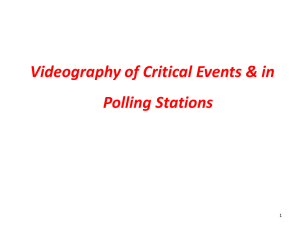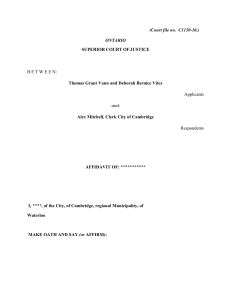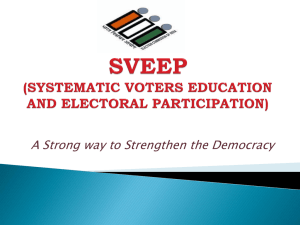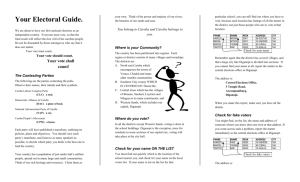Polling station accessibility checklist
advertisement
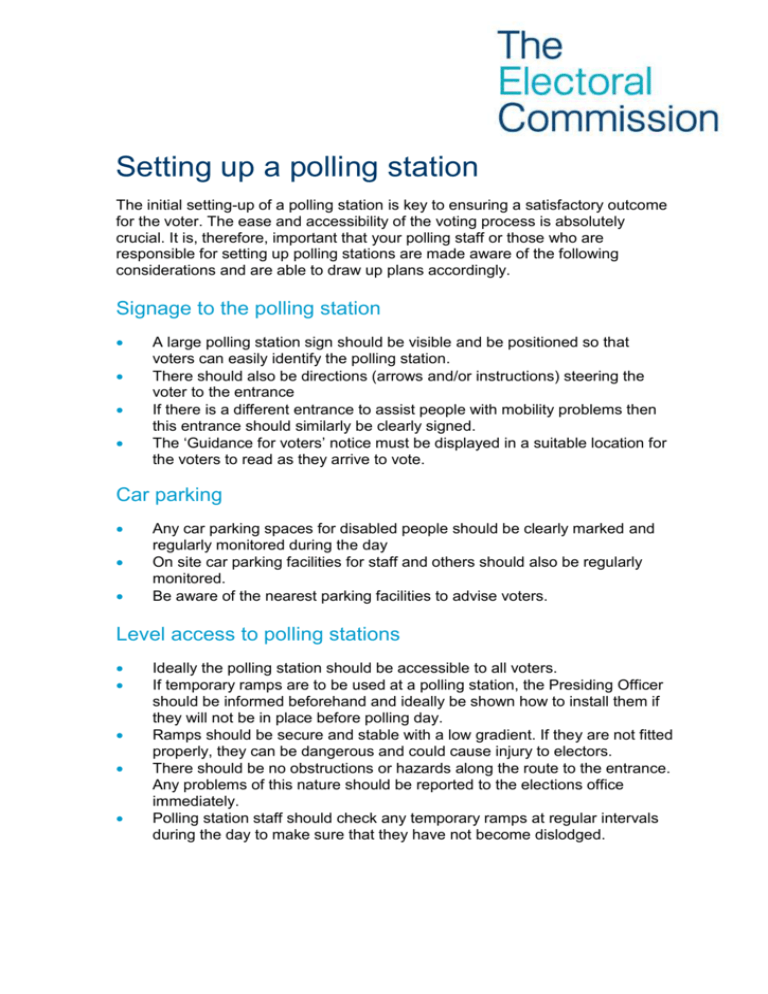
Setting up a polling station The initial setting-up of a polling station is key to ensuring a satisfactory outcome for the voter. The ease and accessibility of the voting process is absolutely crucial. It is, therefore, important that your polling staff or those who are responsible for setting up polling stations are made aware of the following considerations and are able to draw up plans accordingly. Signage to the polling station A large polling station sign should be visible and be positioned so that voters can easily identify the polling station. There should also be directions (arrows and/or instructions) steering the voter to the entrance If there is a different entrance to assist people with mobility problems then this entrance should similarly be clearly signed. The ‘Guidance for voters’ notice must be displayed in a suitable location for the voters to read as they arrive to vote. Car parking Any car parking spaces for disabled people should be clearly marked and regularly monitored during the day On site car parking facilities for staff and others should also be regularly monitored. Be aware of the nearest parking facilities to advise voters. Level access to polling stations Ideally the polling station should be accessible to all voters. If temporary ramps are to be used at a polling station, the Presiding Officer should be informed beforehand and ideally be shown how to install them if they will not be in place before polling day. Ramps should be secure and stable with a low gradient. If they are not fitted properly, they can be dangerous and could cause injury to electors. There should be no obstructions or hazards along the route to the entrance. Any problems of this nature should be reported to the elections office immediately. Polling station staff should check any temporary ramps at regular intervals during the day to make sure that they have not become dislodged. Entrances to polling stations All doors, especially those on designated disabled access routes should be permanently propped open. Fire doors however, must not be propped open. Ensure doormats are flush with the floor. Any loose mats should be removed if they are likely to present a tripping hazard. Inside the polling station Polling station staff should set up the station in such a manner that the voter can move smoothly through the process especially if there is limited space within which to work. The staff themselves must consider the best place to site themselves, the ballot box and the polling booths, ensuring that people can easily identify the staff, move to the voting booths and then to the ballot box without causing problems to themselves or other voters. The ballot box must be accessible to all (including voters in wheelchairs) but must also be located in such a way that they are secure throughout the day. If polling agents have been appointed make sure they are positioned so that they can observe the process without interfering with the voters. Lighting of polling stations Adequate lighting is important for all voters but especially for people with visual impairments. Many people’s vision is dependent on the quality of lighting, especially for reading and writing. Good lighting, both in the polling booth and where the large-print versions of the ballot papers are displayed, is vital. Lighting outside the polling station, particularly in the area leading up to the entrance, should be checked to ensure it will be effective for evening voters. Low-level polling booths and ballot boxes Low-level polling booths should be installed in every polling station to ensure that voters in a wheelchair are able to cast their vote comfortably and in secret The ballot box should be placed on a chair rather than a table as this allows wheelchair users and other people who are not able to reach ballot boxes on tables the opportunity to cast their vote independently and confidentially. A white strip placed around the slot of the ballot box helps visually impaired people to locate the opening more easily. Instructions to voters Every polling booth must have the instruction notice and it must be checked regularly to ensure it is still there and has not been defaced. Large-print notices of the ballot paper and hand-held sample copies A large-print version of the ballot paper must be displayed inside the polling station for the assistance of voters who are blind or partially sighted. It should, therefore, be displayed in a suitable location to ensure it is visible to the voters that may need support to mark their ballot papers. The legislation also requires that enlarged hand-held copies of the ballot paper, marked as ‘sample’, are available to anyone who requires them. This can be given to voters to take into the polling booth with them. If these are laminated, it helps to prevent them getting torn or dirty. Make sure it is not placed in the ballot box. Device to enable voters who are blind or partially sighted to vote without assistance It is a legal requirement to provide a tactile voting device at every polling station. The tactile template is a device that allows someone who is blind or partially sighted to mark the ballot paper themselves once the details on the ballot paper have been read out, either by their companion or by the Presiding Officer. In many cases, voters who may find the template useful may not be aware that it is available for them to use. It may, therefore, be helpful for polling station staff to suggest to electors that they may wish to use the device where it appears appropriate. The right approach is important to avoid causing offence. Seating Chairs should be provided in polling stations for anyone who needs a rest, ideally a mix of chairs with and without armrests. However, chairs should not be placed so that they get in the way of other voters, nor should they overlook people casting their votes. General Providing an effective service and assistance to the voters is a very important part of the job of the polling station staff. If you think someone needs assistance, ask them first, rather than make assumptions. Presiding Officers could set up a table in the polling station with all the materials for disabled voters, so that they or their companions can see everything that is available to assist them. The attached appendix has been designed for polling station staff to test the layout before they open the station to the voters. Completing this checklist will provide the necessary confidence that the polling station layout has been set up to meet the needs of all the voters. Polling station set-up checklist This checklist should be used prior to the poll opening to ensure that the polling station is set up correctly. Outside the polling station Checked Entrance, exit and approaches Is the approach signage clear and are electors able to easily identify where the polling station is? Are there parking spaces reserved for disabled people? Check there are no hazards between the car parking spaces and the entrance to the polling station. Signage Have you ensured good signage for any alternative disabled access, and can it be read by someone in a wheelchair? Is the ‘Guidance for voters’ notice (including any supplied in alternative languages and formats) displayed outside the polling station and accessible to all voters? Level access Is there a suitable ramp clear of obstructions? Is the ramp stable? If not, contact the elections office immediately. Are doormats flush with the floor? If not, remove them. Entrances Have double doors been checked to ensure good access for all? Is the door for any separate disabled access properly signed? Inside the polling station Is the polling station set up to make best use of space? Walk through the route the voter will be expected to follow, and check that the layout will work for voters, taking into account how they will move through the voting process from entering to exiting the polling station. Would the layout work if there was a build-up of electors waiting to cast their ballots? Is best use being made of the lights and natural light available? Is there a seat available if an elector needs to sit down? Official notices Is the ‘Guidance for voters’ notice (including any supplied in alternative languages and formats) displayed inside the polling station and accessible to all voters? Is the ‘Instructions for voters’ notice (including any supplied in alternative languages and formats) posted inside all polling booths? As you walk through the route that the voter will be expected to follow, are the posters and notices clearly visible, even for wheelchair users? Ensure that the notices/posters are not displayed among other posters, where electors would find it difficult to see them. Polling booths/ballot box Is the ballot box placed immediately adjacent to the Presiding Officer? Is the ballot box correctly sealed? Can a wheelchair user gain easy access to the ballot box? Can a wheelchair user gain easy access to the polling booth? Are polling booths correctly erected and in such a position so as to make best use of the lights and natural light? Can the Presiding Officer and Poll Clerk observe them clearly? Are the pencils in each booth sharpened and available for use? Is the string attached to the pencils long enough for the size of ballot papers and to accommodate both right-handed and left-handed voters? Large-print and hand-held sample ballot papers Are the large-print ballot papers clearly visible to all voters? Are the hand-held samples available and visible to voters? Tactile template Is the tactile template available and in full view? Do all staff know how to use it? Ballot papers Are the ballot papers the correct ones for the polling station and are they numbered correctly and stacked in order? Corresponding number list Are the ballot paper numbers on the corresponding number list printed in numerical order? Do the ballot paper numbers printed on the corresponding number list match those on the ballot papers? Register Do you have the correct register for your polling station?

